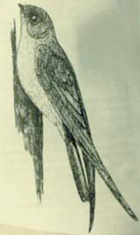 |
 29th August 1999 |
Front Page| |
|
Will
man's greed for the Swiftlet's dainty nest cause its extinction?
Their home, our soupBy Dilrukshi HandunnettiI held the thick, black yet dainty nest in my open palm. So neat and
delicately built, it was a marvel of the architectural genius of the cave-dwelling
bird known as the Indian Swiftlet. And it wrenched my heart to visualize
the plight of this tiny sparrow-like bird which creates its home in a massive
Swiftlet I was obviously holding a goldmine of sorts. For the edible nest of the Swiftlet fetches high prices in Far Eastern countries, ultimately ending up in a soup-testimony to human greed for money and gastronomic appetites. The biggest detection of edible nests in this part of the world was made just last week when the Customs Department confiscated a massive consignment of nests, weighing 44 kg. The consignment was declared correctly, though heavily undervalued at Rs. 55,000 a kg. Authorities imposed the biggest ever fine for the violation of Section 31 of the Flora and Fauna Protection Act, Rs.1.4 million on the exporter. Once again, the Indian Swiftlets, (scientifically known as Collocalia Unicolor) have come to the forefront. Recent Customs detections have bared massive rackets, including an attempt to smuggle 6.2 kg of the edible nests to Malaysia under the guise of 'sea moss'. Samantha Gunasekera, Asst. Superintendent of Customs says smugglers
are devising novel methods Sri Lankan authorities made their first successful detection of birds' nests in 1993. Then the nests came in raw form. In 1995, nests were refined pellets declared as shark fins. This time, they came in the form of small crushed pieces, explained Mr. Gunasekera. "There is a gruesome trend of exploiting the flora and fauna with blatant disregard to nature. Earlier, these nefarious practices were confined to a few errant traders, but there are increasing attempts to export our flora and fauna," Mr. Gunasekera observed. According to ornithological studies, the Indian Swiftlet is the only 'edible nest builder' among the five species of resident Swifts found in Sri Lanka. The bird secretes saliva, which once hardened takes on a white, thick gum like form which is used as nest cement. Swiftlets build in dark caves, occasionally in culverts, tunnels and empty caves. Limestone caves and sea caves are favoured by these birds who neatly saliva-glue their nests to the cave walls. Despite being engulfed by the darkness of the cave they are able to function using echo-location techniques. But the nests originally meant for two tiny Swiftlings have become a thriving trade for exploiters who are catering to Far Eastern markets. The history of edible nest harvesting is believed to date back to the Chinese T'ang Dynasty (68-97 AD) even though there are no written references to such activity. Though there is no scientific research to back this claim, the Chinese, believed these nests possessed aphrodisiac and other benefits. They are considered a Chinese delicacy. Commercialization crept in during the 19th century when British authorities based in India, annually auctioned contracts to export nests to China, a practice which faded due to over-exploitation. In Sri Lanka, nest gathering was practised on a large scale by the native Veddahs, especially during the breeding season. There are references to the ancient practice of nest gathering in the dry zone in R.L Spittel's "Wild Ceylon". It was noted, however, that the nests were cleared, once the Swiftlings were grown. With the illegal trade growing, environmentalists are calling for stringent action against exploiters to protect the threatened bird species. Legal protection According to Jagath Gunawardena, environmental lawyer and member of the Flora and Fauna Protection Advisory Committee, the bird has been protected by law since 1964. It is a punishable offence to destroy birds, eggs or nests and with the 1993 amendment to the Flora and Fauna Act, penalties have also been increased, he said. Therefore, capturing, killing or wounding birds, destroying nests or eggs, selling or offering to sell parts of bird or possession of such, are liable to a fine ranging from Rs. 5,000 to Rs.10,000 and a prison term. But, Mr. Gunawardena sees cause for concern as there is little protection from international trade laws. "In 1994, Italy proposed to enlist Indian Swiftlets under Appendix 2 of the CITES Agreement (Convention on the International Trade in Endangered Species) which was withdrawn later. That would have opened the flood gates for commercial exploitation," he said. As a preventive measure, he proposes having special flying squads to carry out raids and apprehend smugglers and collectors. There should be active police participation to curb the practice, he notes.
|
|||
 |
Front Page| News/Comment| Editorial/Opinion| Business| Sports | Mirror Magazine |
||
 |
Please send your comments and suggestions on this web site to |
||
 colony
in a deep, dark cave.
colony
in a deep, dark cave. to
circumvent the legal framework. Nests are being declared as shark or whale
fins, moss, sea weed and even spider webs!
to
circumvent the legal framework. Nests are being declared as shark or whale
fins, moss, sea weed and even spider webs!  tunnels
are found in abundance.
tunnels
are found in abundance.